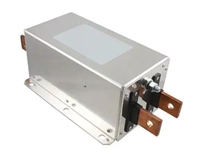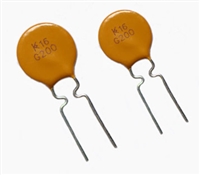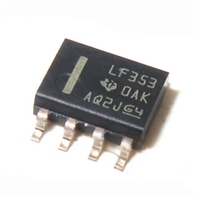AN217
2. Using the C8051F35x Delta-Sigma ADC
Using delta-sigma ADCs require an understanding of how to properly configure the modulator, use of the digital
filter/decimator, and the nature of high-precision measurements of small signal voltages. Additionally, the
C8051F35x family of devices’ ADC provides functions such as calibration and offset adjustment that should be fully
understood when designing with these devices. The following sections describe the signal path from the input
signal source, to the ADC input, through the modulator, digital filter, and finally the output result (16- or 24-bit digital
output). Calibration of the ADC and circuit board design notes follow. Finally, delta-sigma noise specifications are
discussed.
2.1. Signal
The C8051F35x ADC is designed for optimal performance with a modulator sample rate of 19.2 kHz. The ADC is
designed as an oversampling data converter, so the bandwidth of the input signal should be low (the lower the
input signal bandwidth, the better the noise performance will be). The ADC is designed to measure voltages with
high precision.
2.1.1. Getting the Signal to the ADC
To aid high-precision measurements of small voltage signals, the ADC is best configured to input a differential
signal to an AIN+ and AIN– input pin pair. The analog multiplexer (AMUX) can select from eight external channels
of input, an on-chip temperature sensor, and an internal analog ground. The signal source (e.g, a transducer) can
be directly wired to the ADC’s input. If the input is from a pair of wires, twisted-pairs should be used with shielding
to reduce noise where feasible (keep wires as short as possible and away from other signals, especially digital
signals). The main idea is to design a system in which noise will be present equally on both AIN+ and AIN– in order
to reject common-mode noise. (See Figure 6 on page 12.)
2.1.2. Sensor Excitation
Some transducers require an excitation current to generate an output voltage. The C8051F35x devices feature two
on-chip current mode digital-to-analog converters (IDACs) for this purpose. See the data sheet for more details.
2.1.3. Analog Front-End
The input circuit to the ADC pins typically requires filtering and sometimes buffering and gain. Filtering
requirements for a delta-sigma ADC are low, and often the on-chip buffer and programmable gain will suffice.
2.1.4. External Buffer and Gain
The input signal must be kept within the dynamic range of the ADC (determined by the voltage reference voltage)
and within ground and supply voltage. The best measurement performance is achieved when the input signal’s
dynamic range is the same as the dynamic range of the ADC (i.e., voltage reference voltage). When the signal is
much smaller than the dynamic range of the ADC it will require amplification. The on-chip programmable gain or an
external amplifiercan can be used for this purpose. In many applications, a simple op-amp will suffice, but for best
performance choose a low-noise instrumentation or chopper stabilized amplifier.
Many sensors have high-impedance output stages and require a high-impedance input to avoid introducing offset
error. External amplifiers and op-amps serve this purpose. The C8051F35x devices also have an on-chip input
buffer. However, for very high-resolution measurements, the on-chip buffers or external op-amps may not suffice
due to drift (i.e., 1/f noise). For the best measurements, consider the use of chopper stabilized amplifiers (best for
high-accuracy dc measurements) or a low-noise amplifier.
2.1.5. Analog Input Filter
Typically, the only required input circuit needed for a delta-sigma ADC is an RC low-pass filter. While the ADC
shapes and filters noise, there is no noise rejection at the sample rate (19.2 kHz and its multiples). The RC time
constant should be designed to adequately remove noise at the sample rate frequency bandwidth, but not cause
error due to filter settling time as the input signal voltage changes. The ADC samples the signal at a high rate by
switching a capacitor. This results in average current flow into the ADC. This switching current can cause several
inaccuracies in measurement including gain and offset errors and non-linearity if the input filter is not properly
designed. Further, if an input buffer is used (e.g., an op-amp) the switched capacitor could result in amplifier
instability. The RC circuit solves these problems by providing isolation (the resistor) and a charge reservoir (the
capacitor).
2
Rev. 0.2






 电子元器件中的网络滤波器、EMI滤波器与EMC滤波器:分类关系与功能详解
电子元器件中的网络滤波器、EMI滤波器与EMC滤波器:分类关系与功能详解

 NTC热敏电阻与PTC热敏电阻的应用原理及应用范围
NTC热敏电阻与PTC热敏电阻的应用原理及应用范围

 GTO与普通晶闸管相比为什么可以自关断?为什么普通晶闸管不能呢?从GTO原理、应用范围带你了解原因及推荐型号
GTO与普通晶闸管相比为什么可以自关断?为什么普通晶闸管不能呢?从GTO原理、应用范围带你了解原因及推荐型号

 LF353数据手册解读:特性、应用、封装、引脚说明、电气参数及替换型号推荐
LF353数据手册解读:特性、应用、封装、引脚说明、电气参数及替换型号推荐
